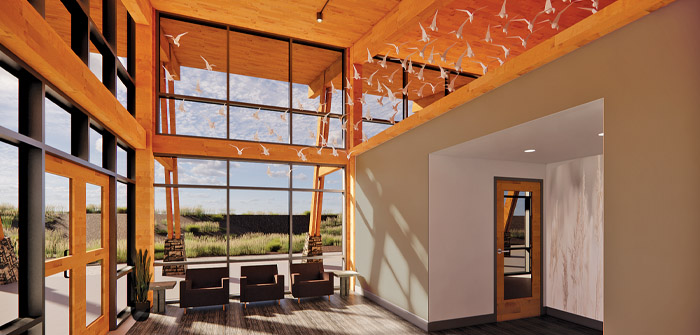(Current commercial interior design trends include drawing inspiration from nature to promote a sense of well-being for occupants. This office building places a sculpture of migrating birds in the light-filled space | Rendering courtesy SĀJ Architecture)
Look for Colors & Finishes Inspired by Nature, as well as Lighting & Technology that Promotes Occupant Health & Comfort without Dominating Spaces
Thoughtful and well-designed commercial interior architecture and materials support the well-being of building users. Over the last few years, we’ve seen the emergence of “resimercial” design, combining comforts of home within commercial spaces. We will continue to inject these details into our commercial interior designs as we strive to provide welcoming, warm, and energizing surroundings. The goal is helping users feel calm and joy while inspiring a sense of relief from the ever-changing, and sometimes overwhelming, world around us. Here are five related trends we’re currently seeing.
1. Colors From Nature
Taking cues from nature, uplifting shades of blue and green are playing a dominant role in color palettes, along with warm, earthy tones like terracotta, yellow, and even purple—all complementing a warmer base palette of creamy whites and beige. Gray shades have taken a back seat as designers and owners seek softer, less sterile environments. Sherwin Williams has announced “Upward” as its color of the year, which is a pale blue described as “breezy and blissful,” a concept we can all get on board with to feel a sense of calm and renewal.
2. Biophilic Design Elements
Again, inspired by nature, we’re incorporating biophilic design into our school, public agency, health care, and multifamily projects. Biophilic principles focus on connecting occupants to the natural environment and, in doing so, foster learning and a sense of well-being. We offer direct access to natural light and capture outdoor views whenever possible. We also bring greenery inside the building via living walls and potted plants, which help create healthier and nurturing environments.
3. Natural Materials
Current commercial interiors are featuring natural materials, textures, and patinas on lighting fixtures, flooring, and upholstery, with a focus on sustainable and nontoxic choices. We’re also seeking to include artisan, handcrafted elements such as tiles and furniture to contribute a warmer, more approachable environment. Adding interest with invigorating pops of color and thoughtful bold accents allows users to meander and feel joy and inspiration.
4. ‘Quiet’ Technology
Technology is integral to how buildings and people work; however, we’re moving away from the “tech” aesthetic’s hard, graphic features and toward a softer approach, where technology moves behind the scenes to become more of a “silent partner” within interior spaces. Our technology choices focus on improving user experiences with smart lighting and temperature controls that are customized and adaptable. We are even seeing a shift toward using lighting to mimic users’ natural circadian rhythms, which can support health, rest, and productivity.
5. Maximalist Expression
“Maximalist expression” is making its way into design concepts as a reaction to the minimalism of recent years. Maximalism is an eclectic aesthetic that mixes bold colors, patterns, and textures with a “more is more” mentality. While this can offer the right experience for certain commercial spaces, doing it well still requires an eye for balance and the ability to curate the space so the interiors don’t feel overwhelming or cluttered.
A purposeful interior design and materials selection approach that’s mindful of the user’s experience, thought-provoking, and uncomplicated is always on trend.
Rebecca White, NCIDQ, LEED AP, is a senior interior designer with SĀJ Architecture. She has more than 20 years of experience creating commercial interior spaces throughout the United States for clients ranging from small business owners to Fortune 500 companies.





